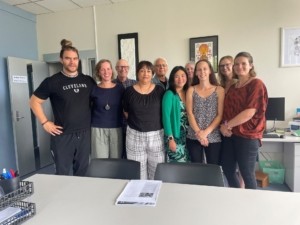
The Nourishing Hawke’s Bay: He wairua tō te kai team based at Te Kura i Awarua Rangahau Māori Research Centre at EIT | Te Pūkenga.
The Government’s free school lunch programme Ka Ora, Ka Ako has high potential to benefit students, their whānau, and communities, but needs continued investment, a review article by EIT | Te Pūkenga and University of Auckland (UoA) researchers has found.
The research provides evidence that Ka Ora, Ka Ako can improve children’s nutrition and educational outcomes; improve child and whānau food security; enrich school learning environments; boost local economies and enhance local foodscapes. It may also increase food system resilience; and encourage broader food system transformation.
Ka Ora, Ka Ako provides free healthy lunches to 220,000 learners in low-equity New Zealand schools at a cost of $263m for 2022/23.
The article; Not Just a Free Lunch, a logic model and evidence review for the Ka Ora, Ka Ako | Healthy School Lunch programme has been published in Policy Quarterly produced by Victoria University of Wellington.
The research also found that some areas within the programme need further attention, including ensuring high quality of food; providing more avenues for children and parents to engage with the programme; addressing perceived challenges to integrate Ka Ora, Ka Ako effectively with mātauranga Māori; and improving waste management. The review also draws on previous ground-breaking research done through Nourishing Hawke’s Bay: He wairua tō te kai, a collaborative local project between EIT | Te Pūkenga and UoA. This research documented local student and whānau perspectives of the programme and demonstrates the potential of the programme, especially when schools cook the food on site. The research was part of the Nourishing Hawke’s Bay: He wairua tō te kai focus on regional food security research projects.
Prof David Tipene-Leach, co-director of Te Kura i Awarua Rangahau Māori Research Centre at EIT | Te Pūkenga and co-author, says: “This review article of the international evidence around school lunches and our experience so far in New Zealand, including our most recent He wairua tō te kai research, makes a telling case for the programme to be maintained and expanded.”
The article’s lead author, Dr Kelly Garton, a Research Fellow at UoA, says moving to a model of universal delivery of the programme in schools is key.
“Aotearoa has the opportunity to join world-leading countries in healthy school food provision. With continued investment and a few strategic adjustments to its implementation, this programme has the potential to transform the dietary health of the next generation, as well as foster a healthier and more sustainable food system.”
Participating schools are already seeing the benefits of the healthy lunches. Te Kura o Kimi Ora Administration Manager, Natasha Walker says: “The biggest change I’ve noticed has been in their health. Prior to the healthy food, the kids were having a lot of boils and skin conditions and scraps and cuts were getting infected straight away – but now their bodies are healing so much faster.”
“One of the big things we are noticing is that they’ve got this sustained learning period. Before 1.30 – 2pm they were having massive crashes and the learning was a lot harder for the teachers.”
Maraenui Bilingual School Principal, Chris Worsely says the benefits of Ka Ora Ka Ako for his kura have been outstanding.
“Tamariki are fed warm nutritious kai every day. We are working on involving the tamariki in the next level by growing and preparing some of the kai themselves with an aim to be lifelong producers and consumers of their own kai.”
Flaxmere College Principal, Jim Hay-Mackenzie, says: “Students are enjoying the sense of whanaungatanga that they experience by eating together. Staff are noticing that students are settled and more focused in the period immediately after the lunch break.”
Irongate School Principal, Maurice Rehu, says the programme has enabled his school to remove some of the barriers in the community.
“Kai and providing kai for our tamariki means it is one less worry for our whānau to get our kids to school. It means all our tamariki are fed and they are able to focus on learning.”
The authors of the article are Kelly Garton, a research fellow at UoA; Chelsea Riddell, a research assistant at UoA; Pippa McKelvie-Sebileau, doctoral candidate at UoA, EIT researcher and former manager of Nourishing Hawke’s Bay; Rachael Glassey, senior research fellow at EIT | Te Pūkenga and current manager of Nourishing Hawke’s Bay; David Tipene Leach, Professor of Māori and Indigenous Research at Te Kura I Awarua, EIT | Te Pūkenga; David Rees, founding partner of research and consulting firm Synergia; and Boyd Swinburn, Professor of Population Nutrition and Global Health at UoA and member of Te Kura i Awarua Rangahau Māori Centre.
